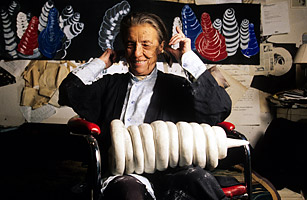
Though she worked for decades in relative obscurity, the French-born American artist, who died May 31 at 98, was in some ways the ultimate insider. With wit, courage and a bewitching perversity, she tunneled deep inside both the body and the psyche and returned with work of surpassing and hypnotic strangeness. Wood, marble, latex, wax and bronze were her materials. So were anxiety, anger, bitter memory and a longing for refuge.
Born in 1911, she grew up in Choisy-le-Roi, where her parents ran a tapestry workshop. Her father's many extramarital affairs — including a long involvement with her governess — left her with a lifetime of resentment that she channeled into her art. In 1938 she married an American art historian, moved to New York and began exhibiting. But it wasn't until 1982 that she became abruptly famous with a retrospective at the Museum of Modern Art in New York City — the first there for any woman artist — that proved she was not only a brilliant inheritor of the Surrealist tradition but a feminist pioneer. Ahead of her was some of her most widely seen work, like the ambivalent homage to her mother called Maman — a giant spider exhibited around the world. She roared into her 70s as the insider who finally broke out.
—Richard Lacayo
This text originally appeared in the June 14, 2010 issue of TIME Magazine.